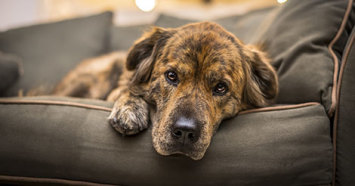
It's that awful nightmare that can happen to any dog owner. You are both out for your evening constitutional, doing the usual rounds of the neighborhood, when Max lunges on the leash at a chirping squirrel and wham, he suddenly pulls up short, limping severely. Poor old Max has likely torn a cruciate ligament in his knee.
What are cruciate ligaments?
Cruciate ligaments are found in the stifle (knee) joint of dogs and cats. Surprisingly, dog and cat knees are very similar to human knees - who knew!
Cruciate ligaments are large and strong ligaments in the knee, keeping it stable and prevents inappropriate movements within the knee joint including hyperextension and excessive internal rotation.
What happens when a cruciate ligament tears?
When a cruciate ligament tears, the dog experiences sudden pain and often holds his leg up. The dog may put the leg down and start using the leg again within a day or so, but will continue to limp for several weeks. Normally, at the end of several weeks, the initial pain subsides and the dog is willing to use its leg more; however, the joint will stay unstable.
Longer term, when your dog puts his weight on the leg, the tibia (shin bone) slides forward in relationship to the femur (thigh bone). As you can imagine, this can be painful as the joint cartilage wears down, leading to arthritis. This motion can also put excessive stress on the menisci (C shaped pieces of cartilage within the knee joint), causing damage or tearing. Not a fun place for Max to be.
Diagnosis
Your veterinarian can diagnose a ruptured cruciate ligament by feeling your dog's knee moving abnormally. The knee feels like it's moving like a drawer of a cabinet instead of being locked in place.
Treatment
Complete tears are usually treated with surgery, which involves using synthetic suture material, or a portion of adjacent fibrous tissue to basically re-create the ligament. Types of treatment include the extracapsular imbrication technique, fibular head transfer, and tibial plateau leveling (aka TPLO).
The most important thing about the surgery is the after treatment that you must do. Your dog's movement must be severely restricted for 2 weeks. Of course, as the days tick by, your dog will be able to put some weight on the affected leg and then want to start running madly around (that's how he got the tear in the first place!) but it's really important to keep them restricted until the healing is complete. Definitely a case of following your veterinarian's instruction to the letter.
Sometimes, a cruciate ligament tear can be healed with medical treatment. Basically, the treatment involves controlled swimming and walking, as instructed by a veterinarian, to keep up muscle strength.
Overweight dogs (no, we never have those!) need to go on a reduced-calorie diet to lose a few pounds and take the pressure of those poor knees. Your vet may also prescribe nonsteroidal anti-inflammatory drugs (NSAIDS) such as carprofen, etodolac, meloxicam, deracoxib, buffered aspirin, or other medications to reduce inflammation in the joint and relieve pain (note: do NOT give your cat aspirin unless prescribed by your veterinarian.) Your vet might also recommend joint health supplements with glucosamine, chondroitin, perna mussel, polysulfated glycosaminoglycans, and other chondroprotective agents.
If you don't treat your dog with a ruptured cruciate, he will usually end up with a severe arthritis and may rupture the other knee because of the extra weight being put on it.
Prevention
How to avoid this in the first place:
Keep your dog's weight down in the appropriate range.
Use supplements for joint health (glucosamine, chondroitin, perna mussel, etc.) Many pet parents consider joint supplements to support their dog's knee health. How much glucosamine for dogs to use can vary based on factors like size and specific needs, so it's important to consult with your veterinarian for appropriate dosing guidelines.
Keeping your dog from jumping up, suddenly going from 0-50mph in 5 seconds, and other normal doggy behaviour that is darn well impossible to prevent.
And of course, best to have your dog insurance before this happens to your dog because you can't get it after.